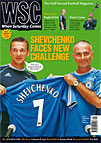 Daniel Gray discovers that the past of Arsenal's recent opponents Dinamo Zagreb is far from ordinary
Daniel Gray discovers that the past of Arsenal's recent opponents Dinamo Zagreb is far from ordinary
While the price of refreshments in their pristine Emirates abode is a more likely cause of protest for Arsenal fans than political events, for supporters of Champions League qualifier opponents Dinamo Zagreb the reality at home games is very different. This manifested itself most in the final home game of last season, a 1‑0 victory over Hajduk Split on May 13, when, instead of indulging in the now traditional lap of honour, both club and followers celebrated Dinamo’s Croatian championship triumph by publicly lauding an alleged war criminal and demonstrating against his treatment.
In the days leading up to that match Dinamo had announced that all gate receipts were to be donated to Croatian army generals awaiting trial in The Hague, chief among them Ante Gotovina. With heartfelt paeans to Gotovina ringing around the Maksimir Stadium, £94,000 was raised.
The Dinamo fans’ benevolent mood was undoubtedly heightened by the pre-match screening of video footage from the infamous “Football Riot” of 1990, a violent ruction many view as the trigger for subsequent wider Yugoslavian conflict. Sixteen years ago to the day, Dinamo had been due to host Serbian rivals Red Star Belgrade. With thousands of Red Star fans travelling to the game amid a context of resurgent regional nationalism and growing fissures in Yugoslavia’s federal composition, violence appears to have been inevitable and in all likelihood premeditated.
Naturally, the “facts” of what happened on that day varies according to which side is talking. What can be safely asserted is that fans of both sides, plus the police, found themselves engaged in a savage on-pitch battle and that Dinamo Zagreb’s Zvonimir Boban, later with AC Milan, attained legendary status and a six-month ban by landing a flying-kick on a member of the Yugoslavian constabulary.
Key to the fighting were Dinamo’s and Red Star’s ultra groups, the Bad Blue Boys (BBB) and the Delije respectively. When the Yugoslavian civil war officially began in 1991, members of both groups formed vital components of their countries’ forces. Now a BBB statue outside the Maksimir stands as testament to their efforts, with the role of the Delije in the warlord Arkan’s paramilitary “Tigers” similarly celebrated amongst Serbian nationalists. That the BBB statue reads “To the fans of this club, who started the war with Serbia at this ground on May 13, 1990” says a lot about the influence of Dinamo on Croatian nationalism and vice versa, and offers insight into the support for Gotovina et al.
Gotovina was indicted in 2001 on seven counts of war crimes allegedly committed during the conflict with Serbia by the International Criminal Tribunal for the former Yugoslavia, though his arrest did not take place until December 2005. He stands accused of being the driving force behind the murder, persecution and expulsion of Serbs as part of a Croatian mission in Krajina named “Operation Storm” during the final chapters of the war. However, for many Croats Gotovina and his acolytes are war heroes, gallant resistance fighters in the Che Guevara mould.
Overt support for political causes has rarely manifested itself inside football grounds in this way and where it has gestures have seldom come at the behest of the club itself, as with Dinamo. Any actions designed to raise awareness of issues have usually come from individuals (such as Robbie Fowler’s support of striking dockers, for which he was fined by UEFA, or Inter’s Javier Zanetti and his involvement with Mexico’s Zapatistas).
The rarity of Dinamo’s actions is a voluble symbol of the nature of football in the former Yugoslavia and other post-communist countries. Where teams were once inexorably linked with regimes or their organs, now they are often bound to political causes or parties. Yet in a world where Vinnie Jones of all people is set to play Arkan in a forthcoming film regarding the Yugoslavian conflict (Filthy War), anything is possible.
From WSC 235 September 2006. What was happening this month